What is meant by diamond cut?
Of all of the 4Cs, Cut is the most important. It is man's contribution to the natural beauty of a diamond.
Two diamond crystals of the same carat weight may have the same clarity and color but one may not be as beautiful as the other if each is not cut to maximize its beauty.
Cut and cut grades can be very confusing. Words on the grading reports may sound good, or not, but what exactly do they mean?
How does the GIA grade cut, and what is the "Ideal" cut. We will answer these questions for you, but to understand cut we need to speak to the vocabulary and descriptive words and definitions of "Cut." Let's start with the meaning of cut.
Cut can refer to three things:
1.) The overall shape: (e.g., round or marquise, etc.) and the facet arrangement; step-cut, brilliant cut, or mixed cut, a combination of brilliant cut facets and step cut facets.
2.) The proportions: meaning the angles, depths and the relationship of the parts of a diamond to each other.
3.) The finish: which is the symmetry and alignment of the facets and overall polish.
Parts of a diamond:
But before we talk about cut, it is important that we first identify the parts of a diamond. We are going to focus on the round brilliant cut today, as it is by far the most popular.
The crown is the top portion of the stone.
The girdle is the center of the stone, which is also the setting edge.
The pavilion is the bottom portion of the stone and perhaps the most important in terms of cut. This cone-shaped pavilion acts like a mirror and if well-proportioned will reflect light that enters the stone back to the viewer’s eye.
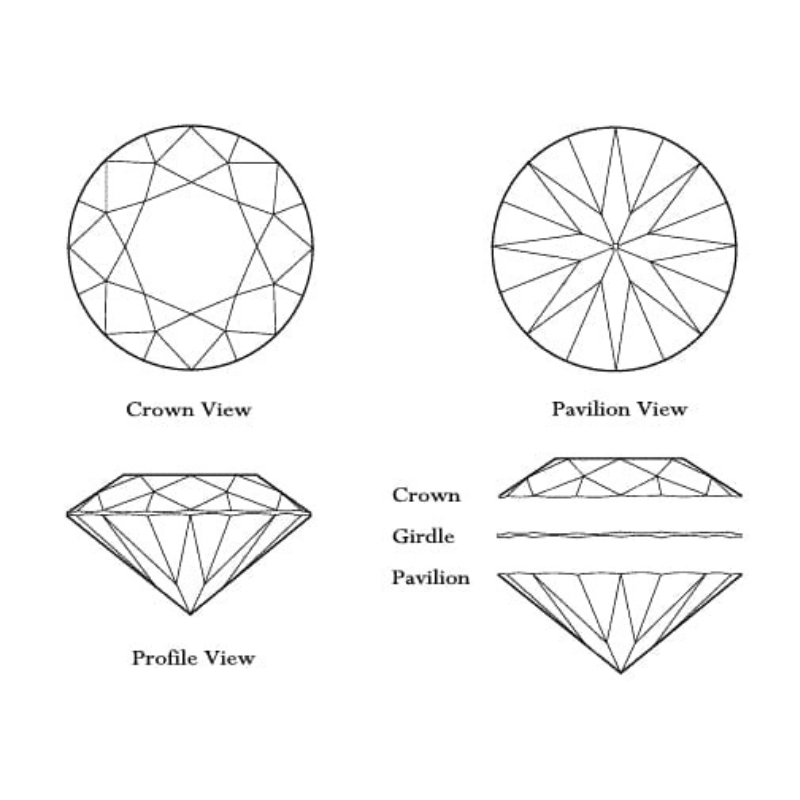
- Round brilliant is the most symmetrical cut
- Comprised of triangular and kite shaped facets
- 57 or 58 facets
- 16 or less facets described as “single cut”
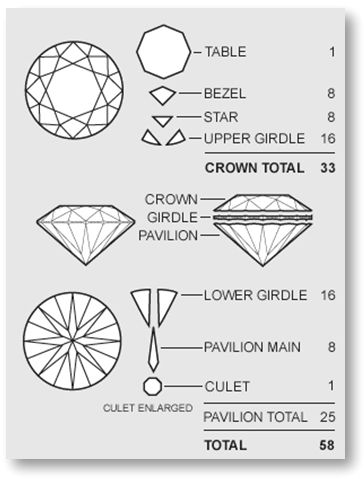
How does a diamond grader determine the quality of cut?
The proportions are the relationships between the sizes of a stone’s various parts and angles. They are important in terms of the stone’s overall beauty, since they, more than anything else, determine the extent to which the stone can achieve its maximum potential in terms of its reflection of light, which translates into beauty.
A well cut diamond will exhibit the following three characteristics:
1. Brilliance or brightness is the return of white light to the viewer’s eye (in the face up position), light reflected from within the diamond as well as from the surface.
2 Fire is the breaking up of white light into spectral colors, a.k.a. dispersion.
3. Scintillation is “sparkle”. It is a display of reflections from the polished facets of the stone and is created by light and movement. Sparkle is the flashes of silver seen when the diamond or light is moved.
These three optical properties must be well balanced in order to maximize the beauty of a diamond.
We normally see dispersion in the facets around the crown rather than through the table, all the colors of the rainbow.
In a well-cut diamond, the facets on the pavilion acts as mirrors. Light should enter the stone and be entirely reflected back out the crown producing a beautiful and even distribution of light.
It is the combination of all the quality factors that contribute to the beauty of a diamond.
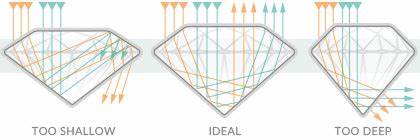
If a diamond is poorly cut, too deep or too shallow, light will leak out the pavilion making the diamond appear dark or gray. The pavilion of the diamond on the right has a pavilion that is cut too deep, on the left, too shallow.
Not all companies cut their diamonds to maximize beauty but rather to maximize size and weight; this means they are sacrificing beauty.
Diamond Shapes:
Brilliant-cut :
The most popular diamond cut is the standard round brilliant diamond. Brilliant-cut diamonds have 57 or 58 triangular and kite shaped facets that highlight brilliance and fire, hence the name “brilliant cut.” 75% of all diamonds sold are round brilliants.
Brilliant-cut diamonds can be shapes other than round. Any diamond other than round is called a "fancy" shape if the stone features kite and triangular shaped facets than it is brilliant cut.
Four examples of brilliant cut fancy shapes are: oval, pear, heart and marquise all comprise triangular and kite shaped facets.
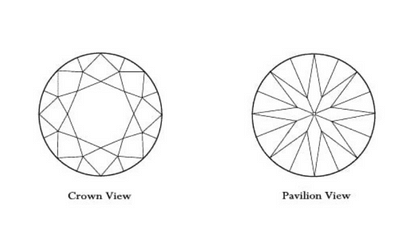
Step-cut:
In addition to brilliant-cut diamonds, there are also step-cut, a.k.a., emerald-cut diamonds. Step Cut is a style of cutting with concentric rows of rectangular shaped facets running parallel to the girdle. The most popular, most familiar, style of step cut is the emerald cut.
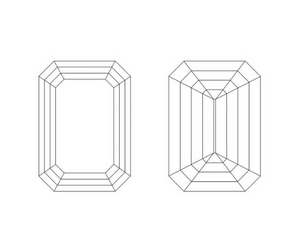
Emerald-cut is a step cut, many having 49 or 50 facets with 24 on top, 24 on pavilion, 1 on the top (table) and 1 culet, if there is a culet or keel line.
Emerald cuts have beveled corners for both esthetic and practical reasons. These beveled corners also provide a more secure setting edge for prongs.
If brilliant-cut diamonds highlight brilliance and fire, what does the emerald-cut highlight?
Emerald-cut diamonds show off the beauty of the clarity and color, much like looking into a beautiful clear lake.
Baguette:
Used primarily as accents stones. They are long square or tapered, as the description "Baguette", as they resemble the long thin French bread loaves they are named for.
Square baguettes, carefully calibrated stones are used in full circle band rings. They generally have 13 0r 14 facets.
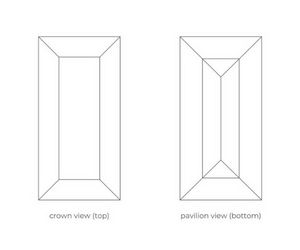
Princess Cut:
Princess cuts are perfectly square diamonds; the length to width ratio should be 1:00-1:00 or can be slightly above that, e.g. 1:00-1:05. This cut features kite and triangular shaped facets.
Many brands have their own modified facet arrangements, but generally have approximately 53 facts.
They are very popular due to their mesmarizing light display. The sharp 90 degree angle corners must be covered by prongs for protection and security.
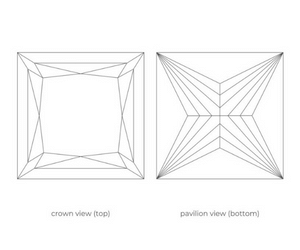
Mixed Cut:
A mixed cut features long straight facets as seen on a step cut, as well as kite and triangular facets as found on the brilliant cut. A good example of a mixed cut is the brilliant radiant cut. They differ from princess cuts as their shape is rectangular. There are many mixed-cut facet arrangements.
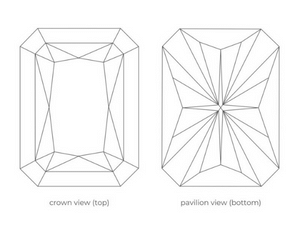
GIA Cut grading scale:
You will see on GIA grading reports a "Cut" grade. What are they and what do they mean? Here is GIA's description of how their cut-grading system evolved and what it offers.
The grades assigned are: Poor cut, Good cut, and Excellent cut. Cut grades are only assigned for round brilliant cut diamonds, not fancy shapes. A preportions diagram and measurements are also provided. The grades are based on the model's prediction and measurement of Brightness (brilliance) Fire and Scintillation (sparkle.)
Ideal Cut:
As mentioned above, the goal of the cut is to maximize light reflected back out of the diamond, as well as to maximize the brightness, fire and sparkle; the inherent beauty of the stones.
Parameters for the ideal cut were first defined by Marcel Tolkowsky back in 1919. He was also the first to lay claim to the name "Ideal Cut."
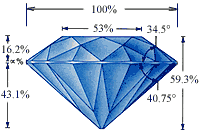
The American Gem Society is most associated with the American Ideal Cut.
Here are the original range parameters for the AGS Ideal proportions for round diamonds:
- Table Diameter: 52.4 - 57.5%.
- Crown Angle: 33.7 - 35.8° degrees.
- Pavilion Angle: 40.15 - 41.20 degrees.
- Girdle Thickness: Thin, Medium, Slightly Thick.
- Culet Size: None, Pointed, Very Small, Small, or Medium.
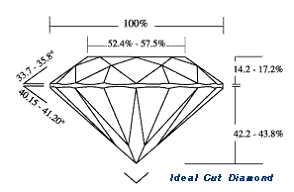
The grading scales can be found on the bottom of an AGSL report. The Cut grade scale is broken down as follows:
0= AGS Ideal
1= Excellent
2= Very Good
3, 4= Good
5, 6, 7= Fair
8, 9, 10= Poor
The end result is diamonds with superior brilliance, fire and sparkle, greater than those diamonds cut to lower standards.
Today, some labs have modified these parameters but still refer to their cut as "Ideal."
If you are purchasing a diamond online, you should now have an understanding of which proportions and grades for cut represent beautiful high-quality stones. Most online diamond sellers post the report for each diamond.
If purchasing a diamond in-store, ask to see the report.
FYI, Lab-created diamond grading systems are the same as used for earth mined diamonds.
They may not be graded in a GIA lab, in fact, most are graded by IGI, The International Gemological Institute, however the GIA or AGS grading scales are used to assign cut grades.
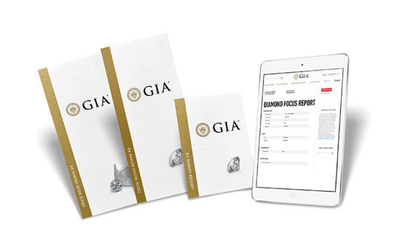
Did You Know…
AGS and GIA just announced the launch of AGS Ideal® Report by GIA. The new report is available for round brilliant and select fancy shapes, including specific facet arrangements of cushion, oval, emerald, radiant, princess, and fancy round brilliant. For additional information, click HERE
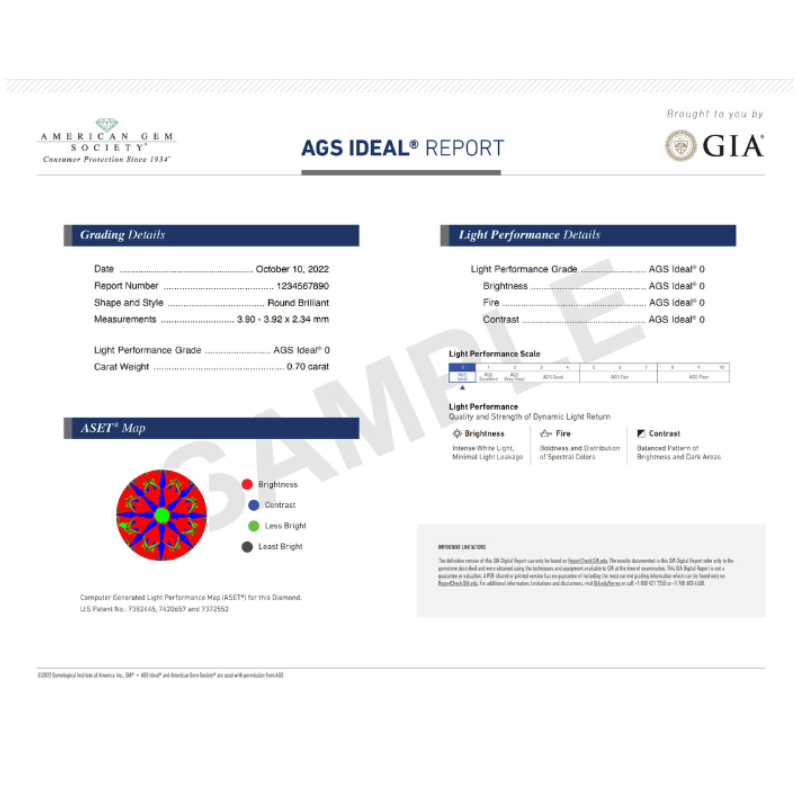
Thank you for taking the time to read our article; we would love to hear from you, so please signup and leave your comments and questions below.
Happy Shopping!
Francesca de Granville, G.G. (GIA) F.G.A.
Related Articles you may also enjoy:
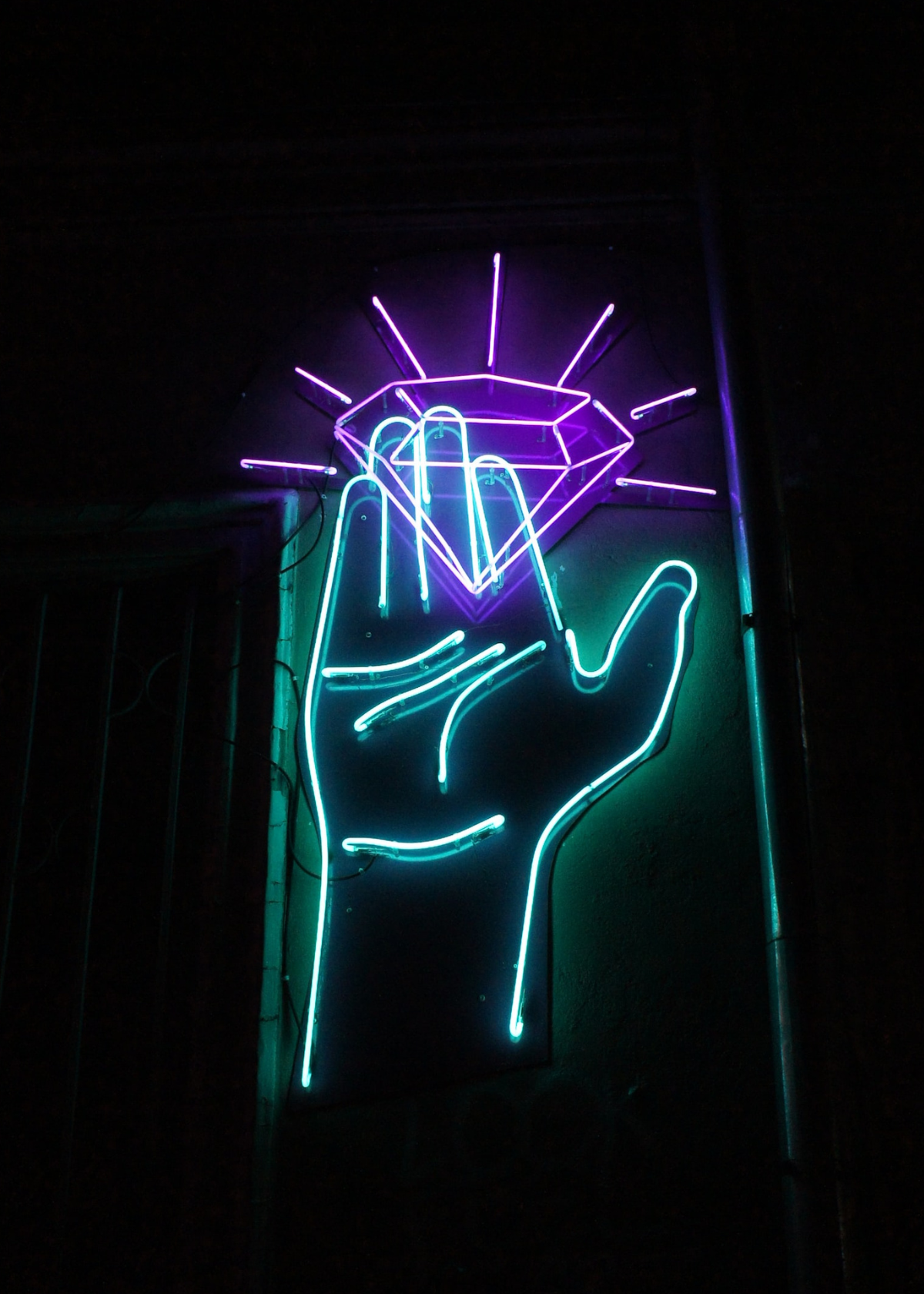
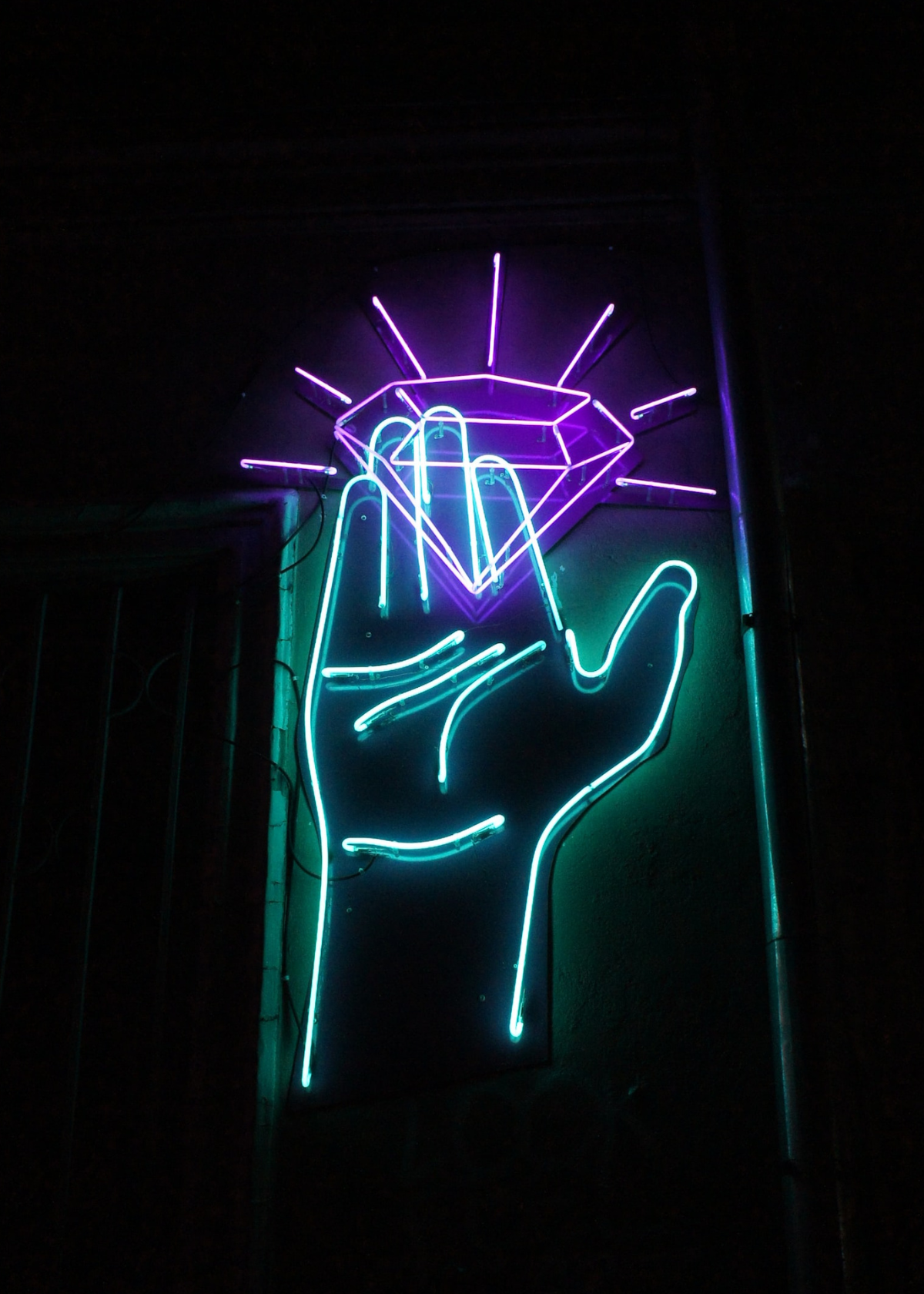
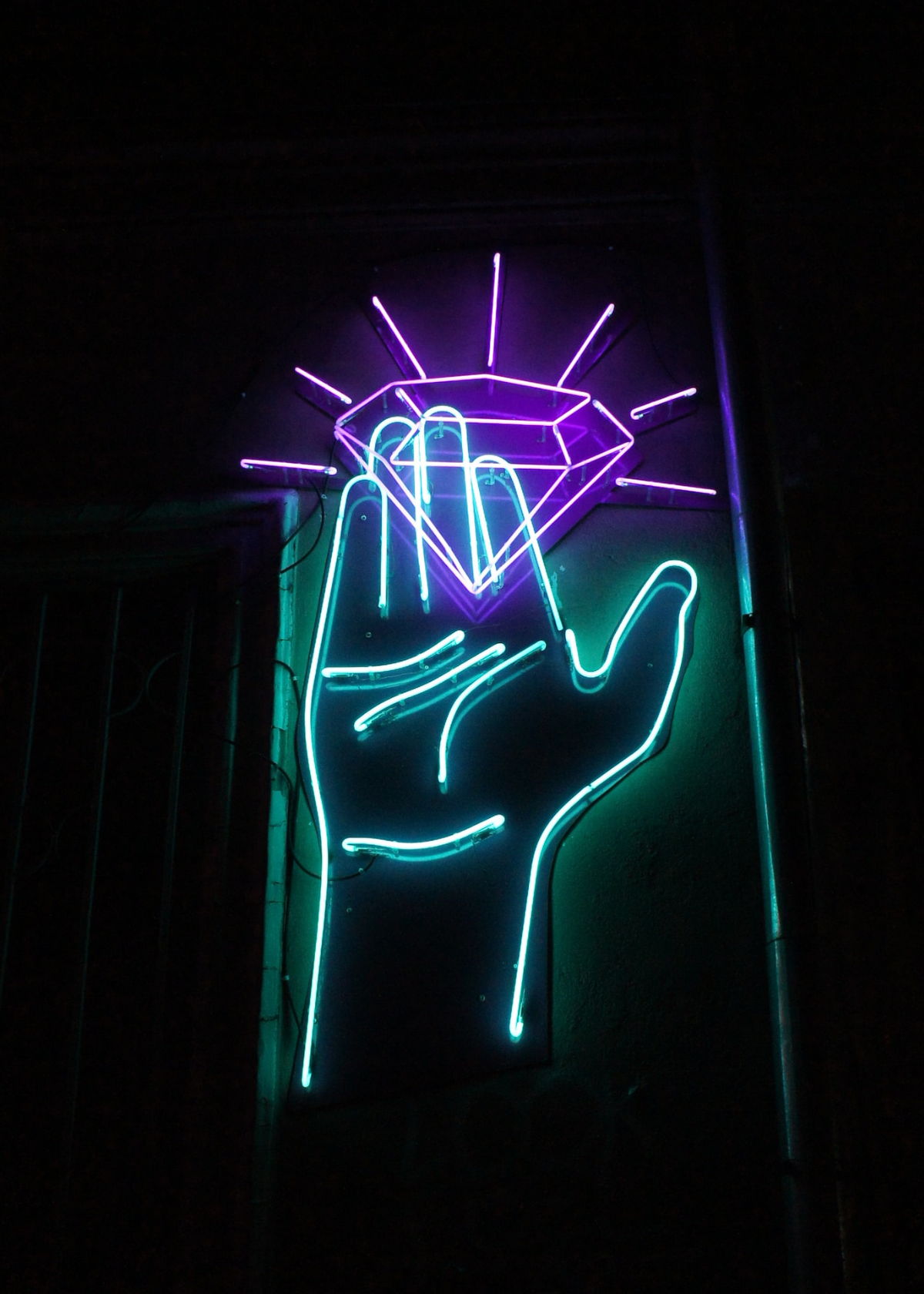
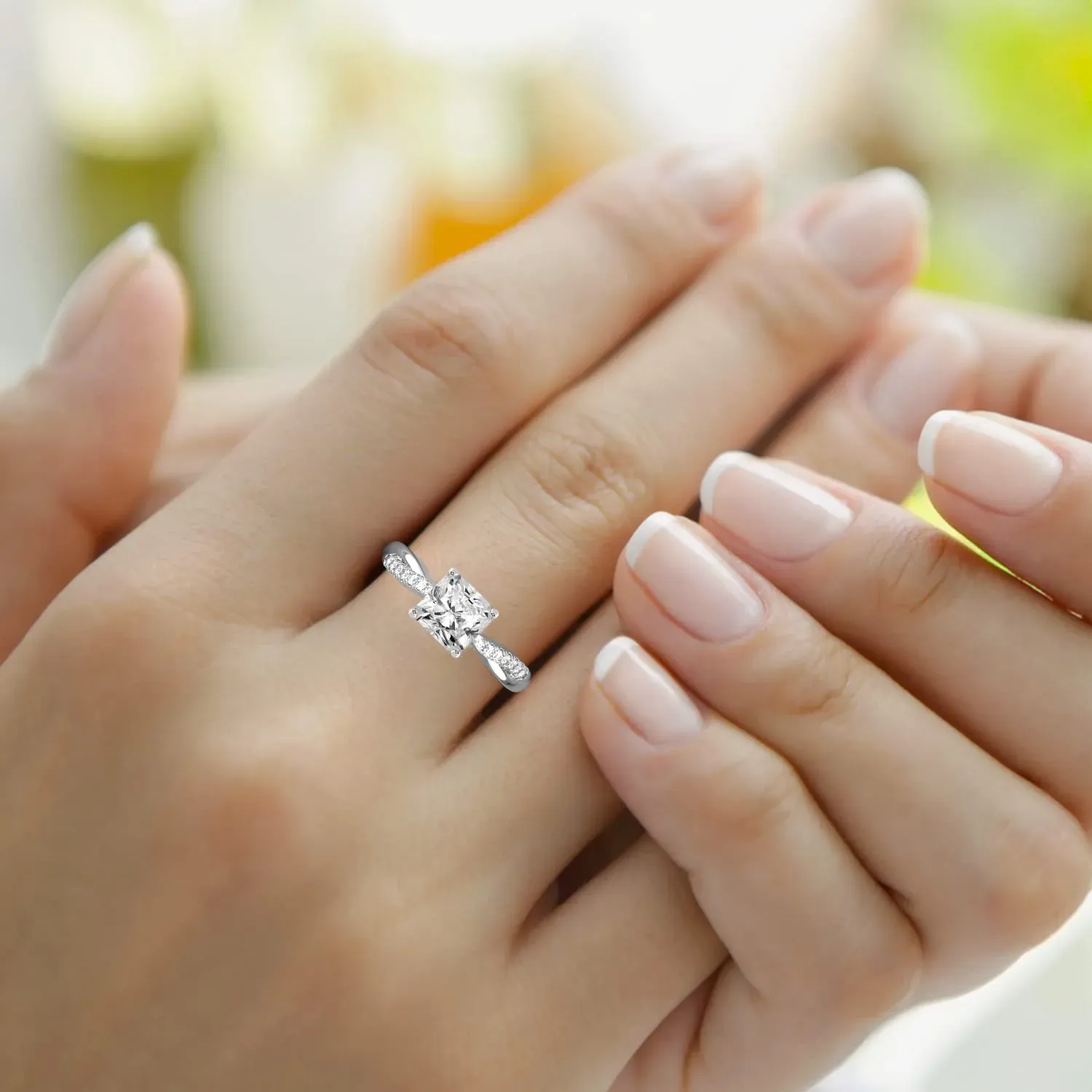

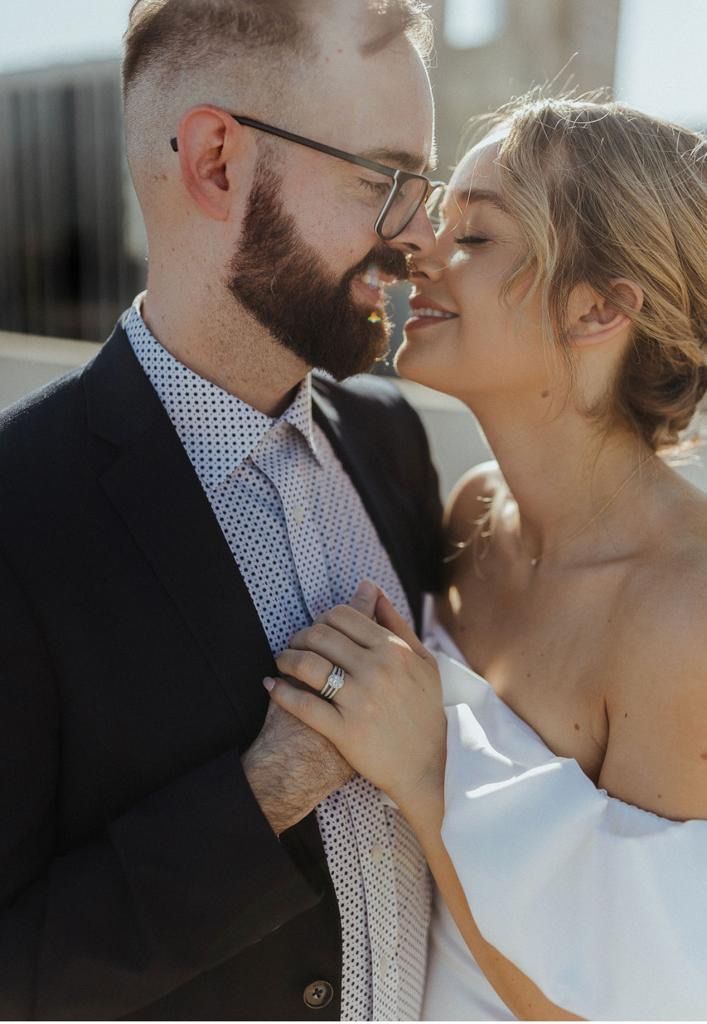
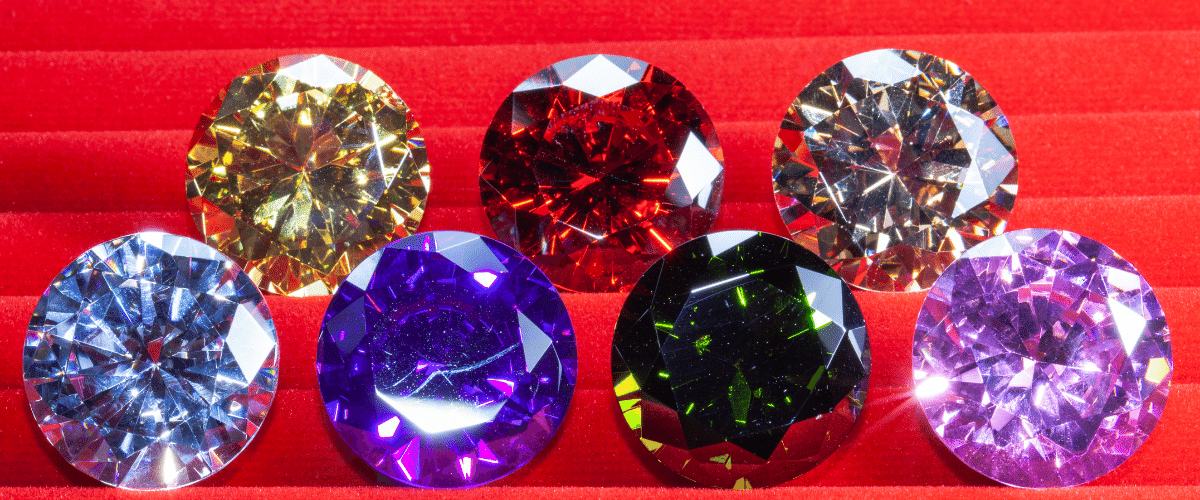

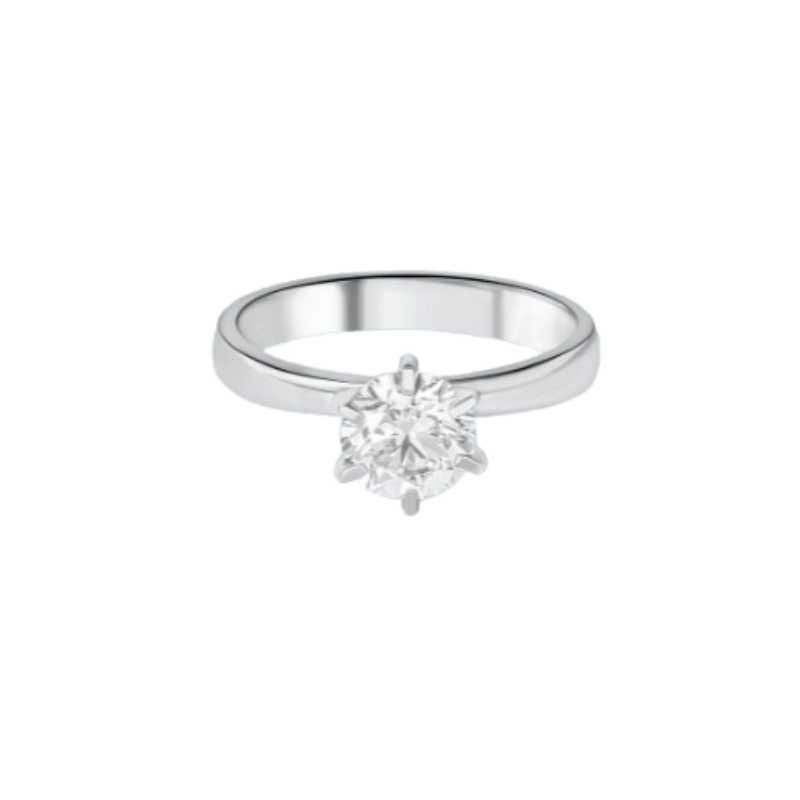




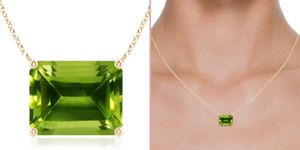
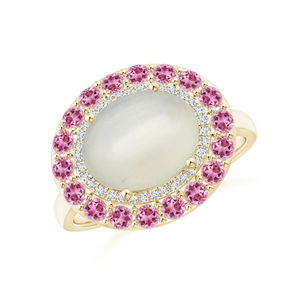
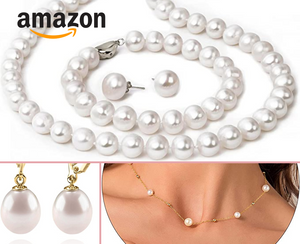


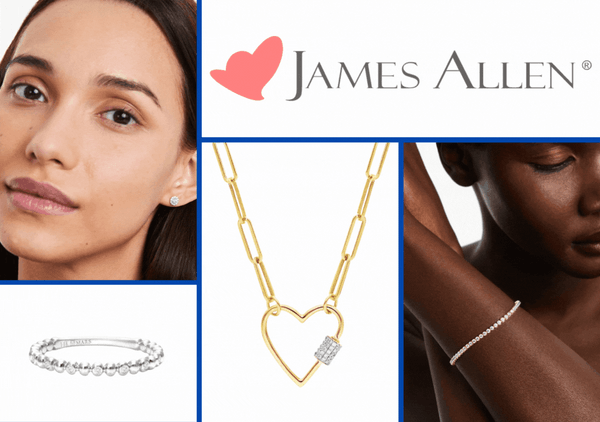
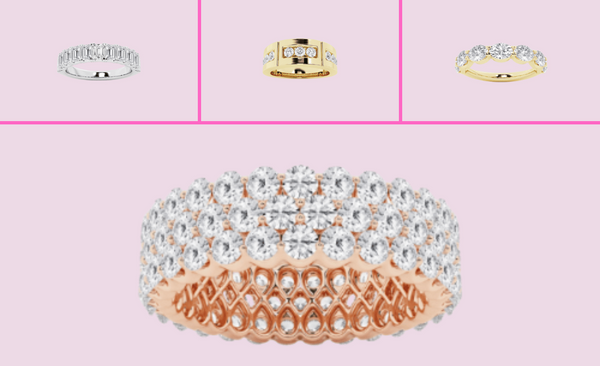
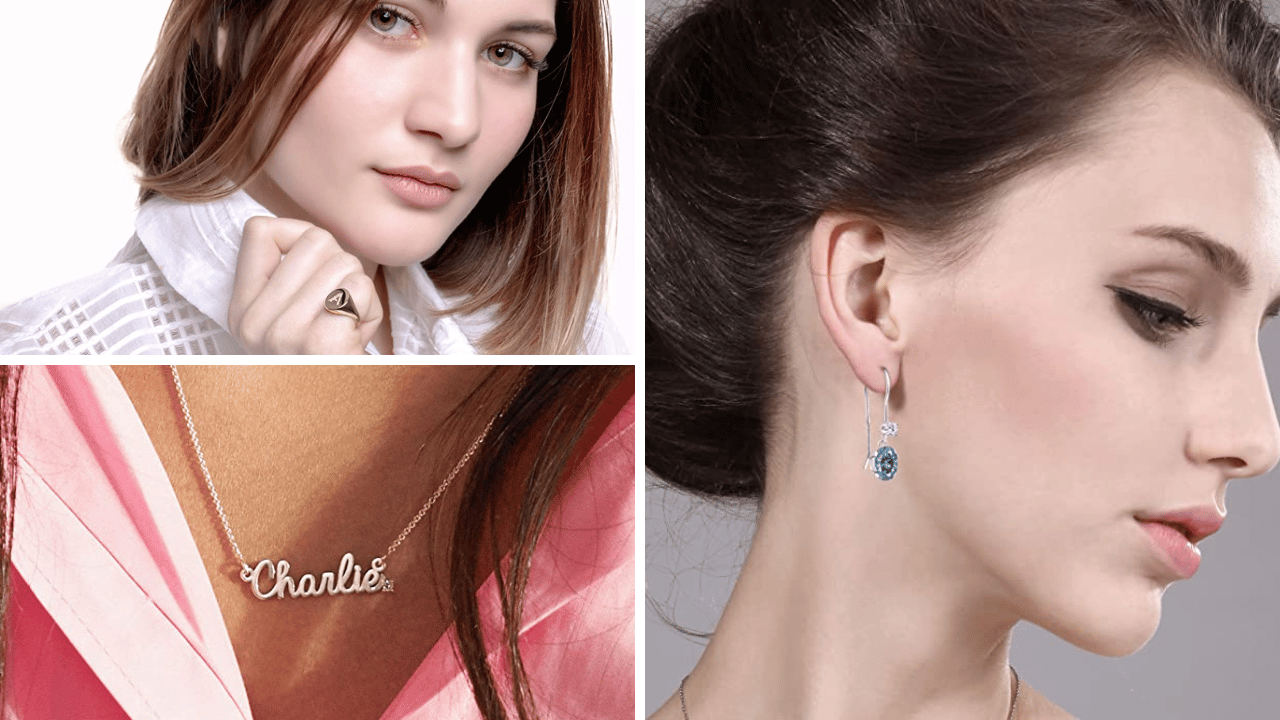
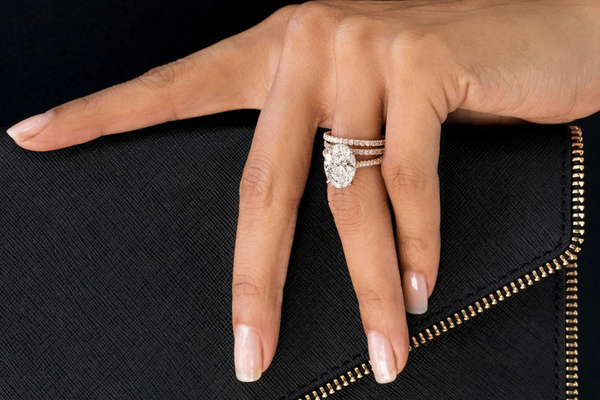
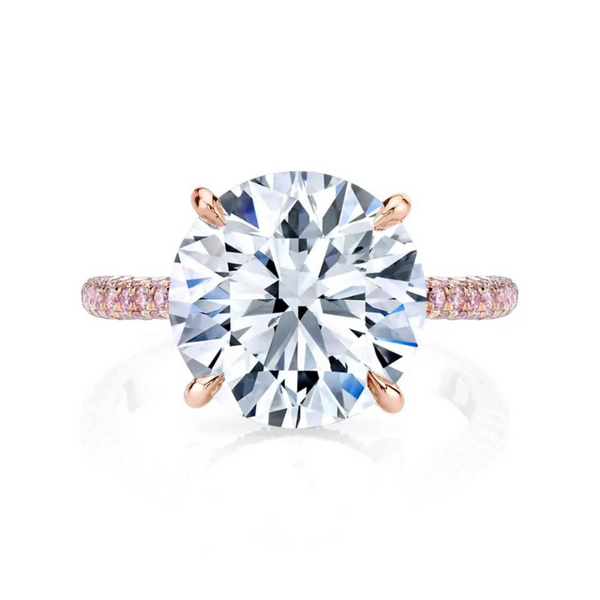
Member discussion